Abstract
We tested the hypothesis that the "self-stimulatory" behaviors exhibited by some individuals may be socially mediated. Four developmentally disabled children who exhibited hand flapping and body rocking participated in a series of three experiments conducted to assess the influence of social variables on stereotyped behavior and to develop a treatment based on the assessment. Experiment 1 used an assessment procedure to determine the relative influences of social attention and task demands on stereotyped behavior. For all four children, hand flapping and body rocking increased when difficult academic tasks were introduced. Experiment 2 involved the use of a procedural time-out and demonstrated that removing task demands contingent on stereotyped behavior resulted in increased rates of hand flapping and body rocking. In Experiment 3, these results were used to develop a communication treatment that consisted of teaching the children to request assistance on the difficult tasks. This treatment resulted in significant reductions in self-stimulatory behavior. These results are consistent with the hypothesis that some forms of repetitive stereotyped behavior may come to serve social functions (e.g., escape from aversive situations). Teaching a functionally equivalent communicative alternative to escape-motivated stereotyped behavior can be an effective form of intervention for this problem.
Full text
PDF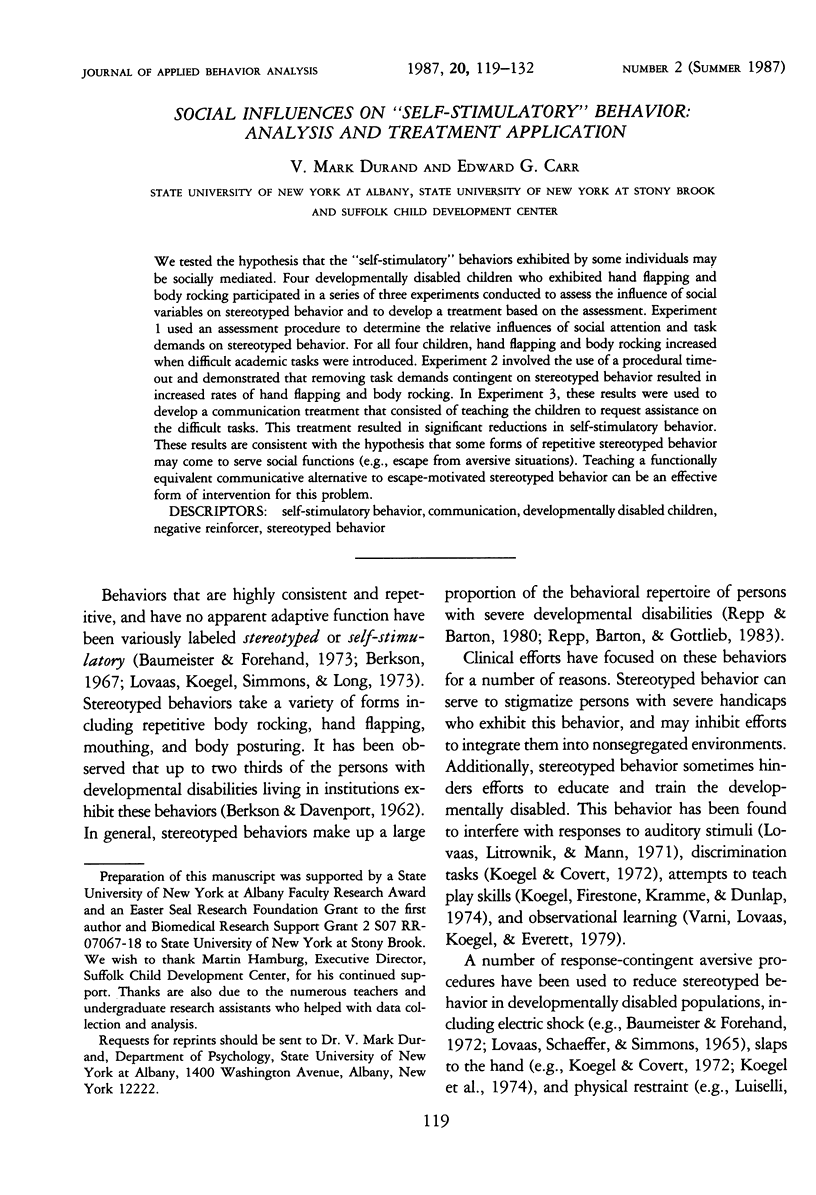
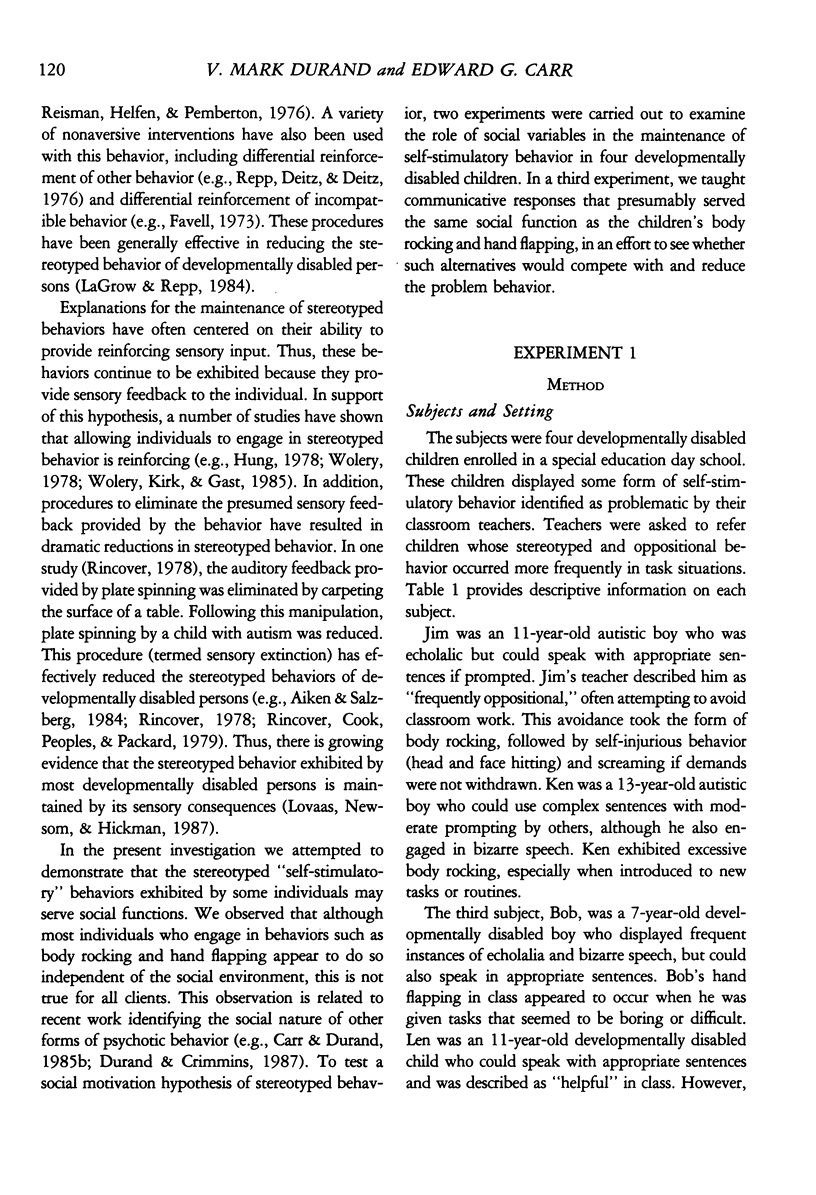
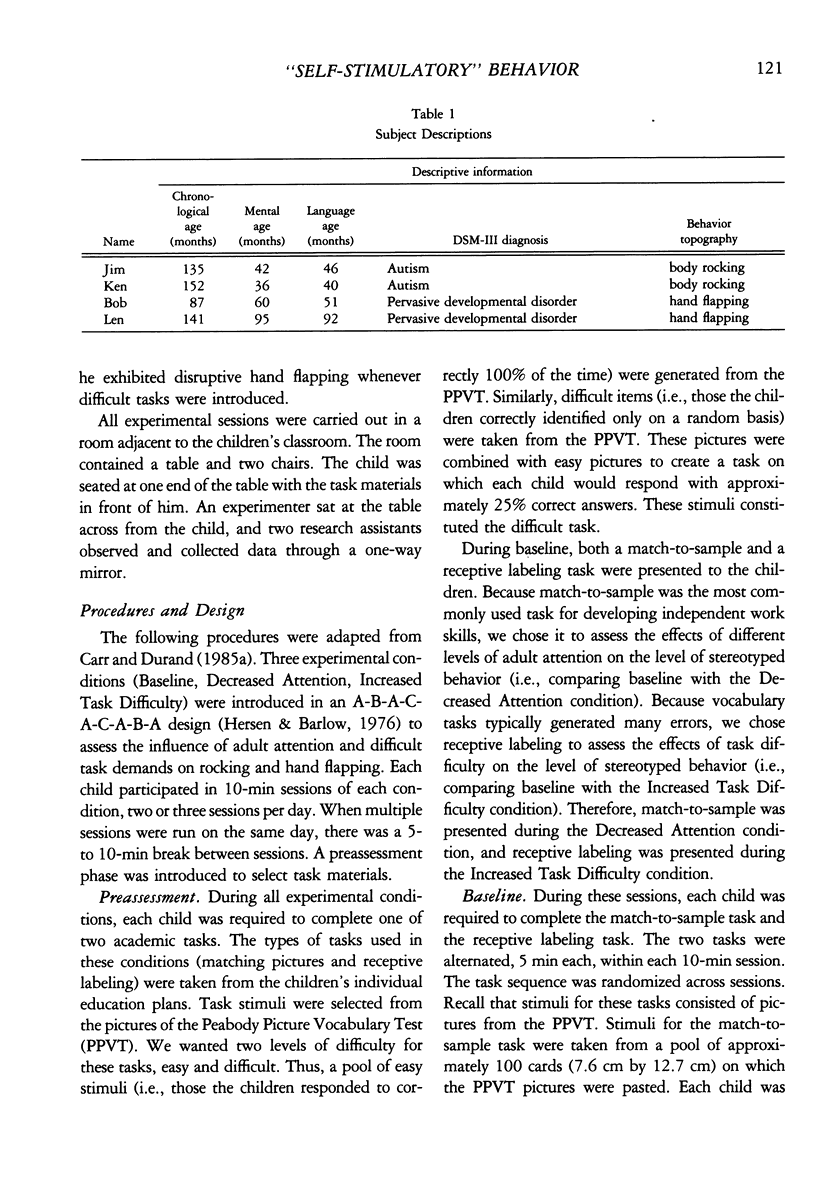
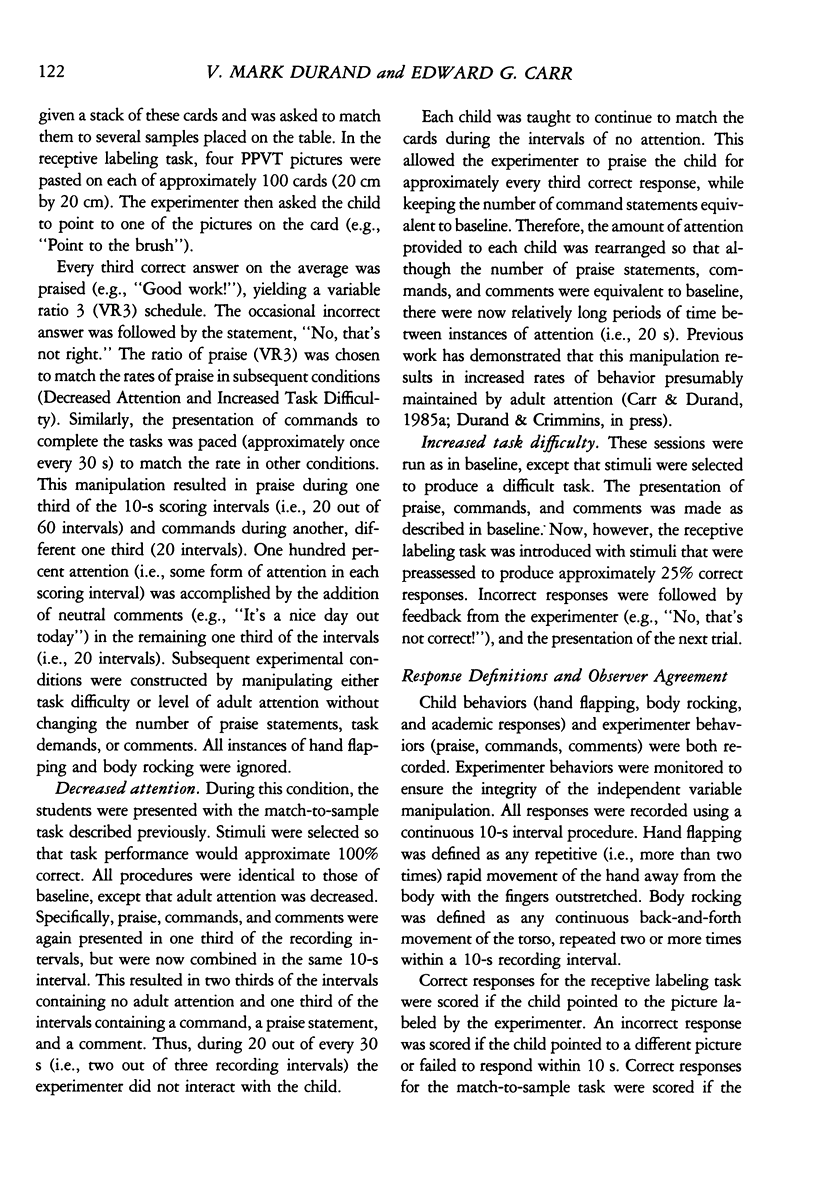
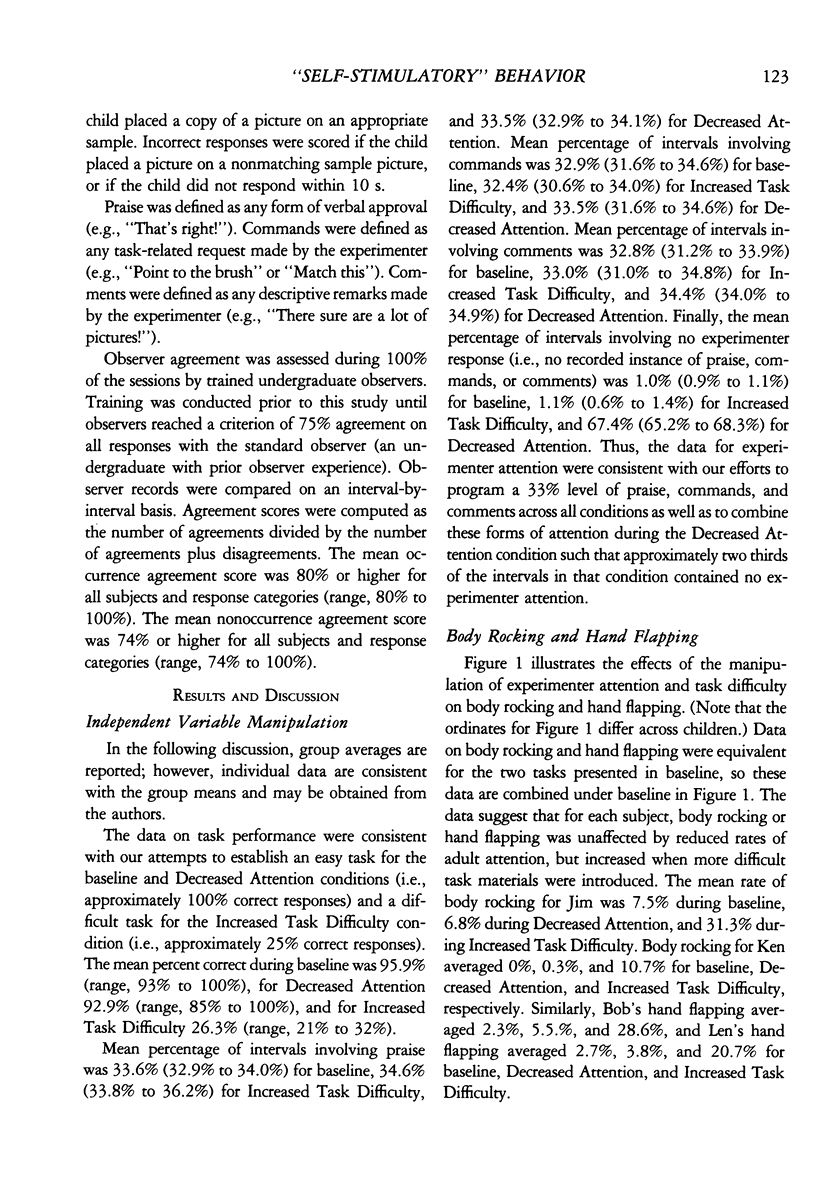
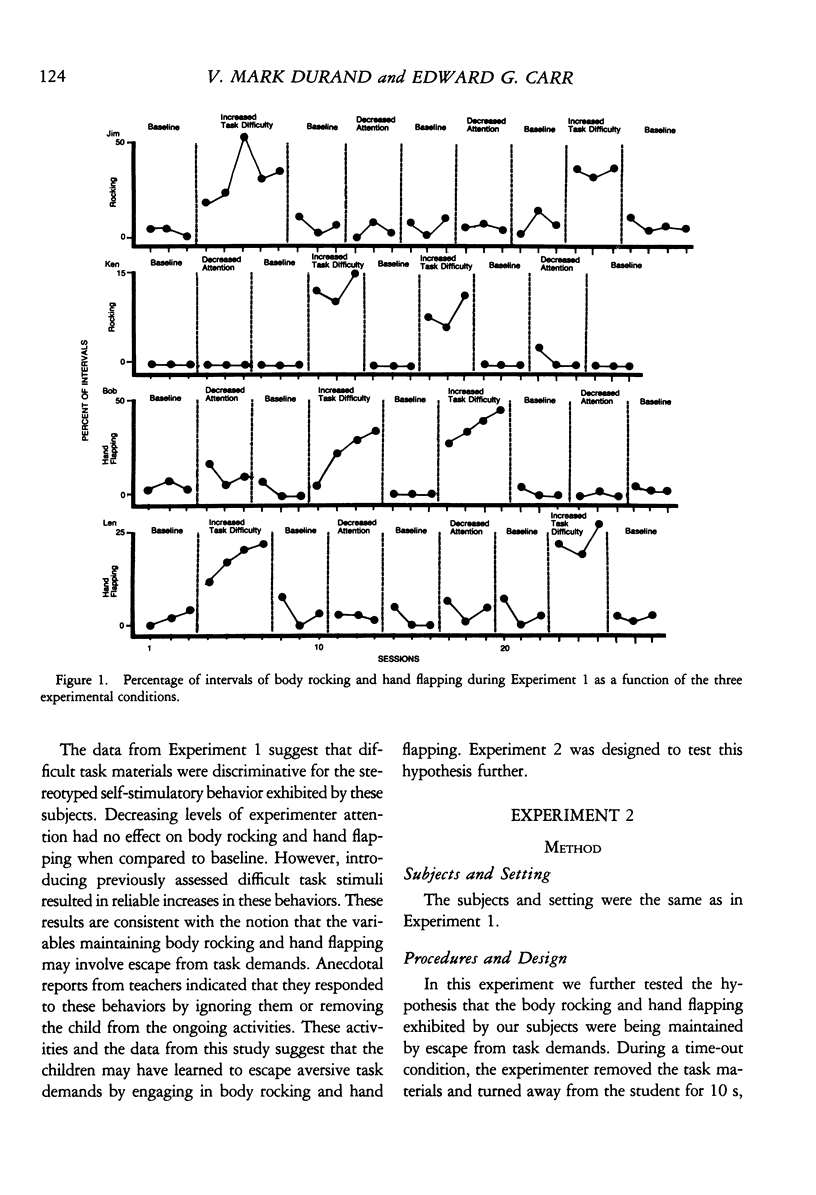
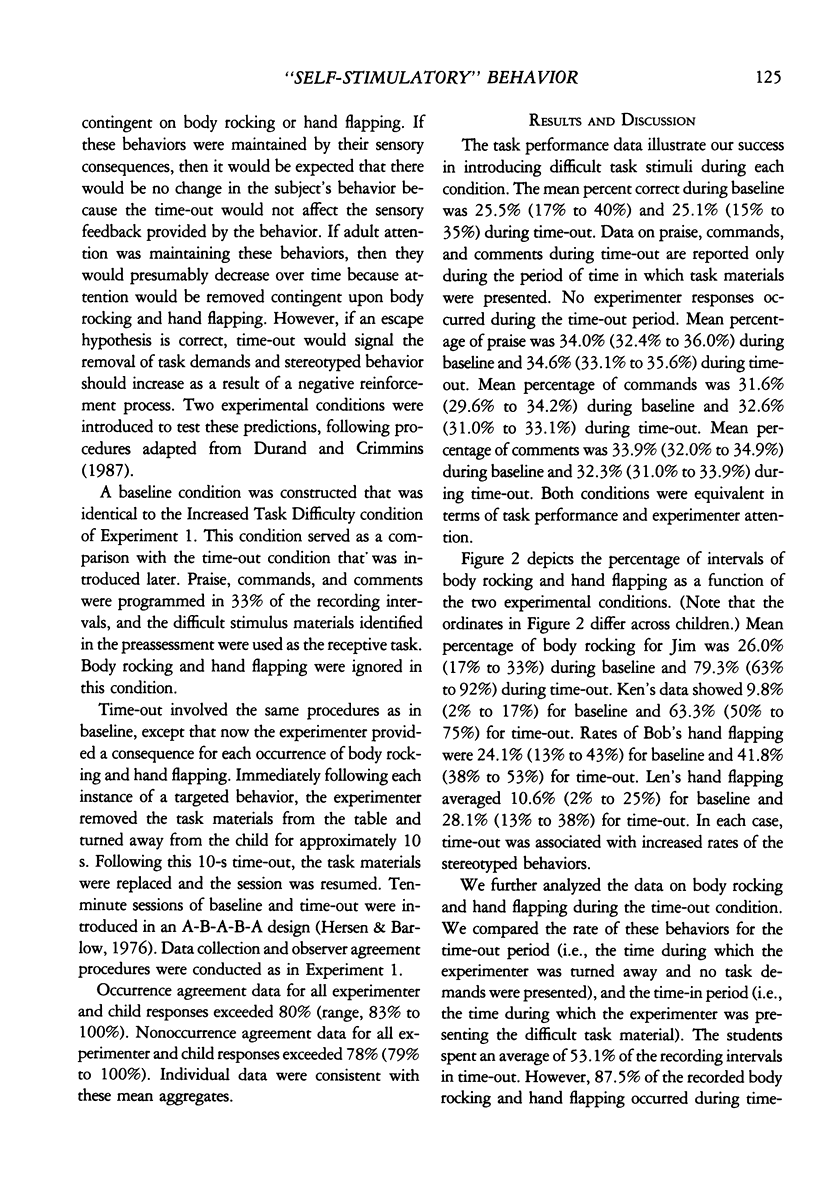
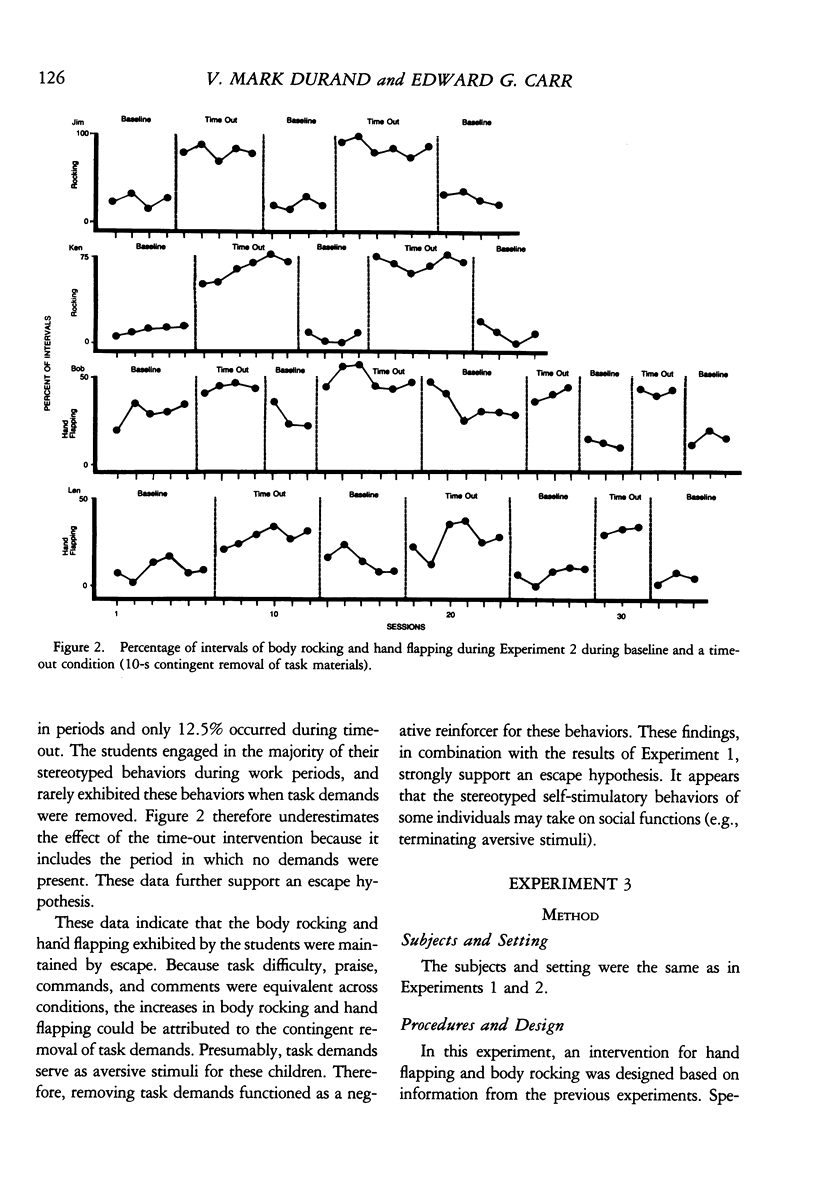
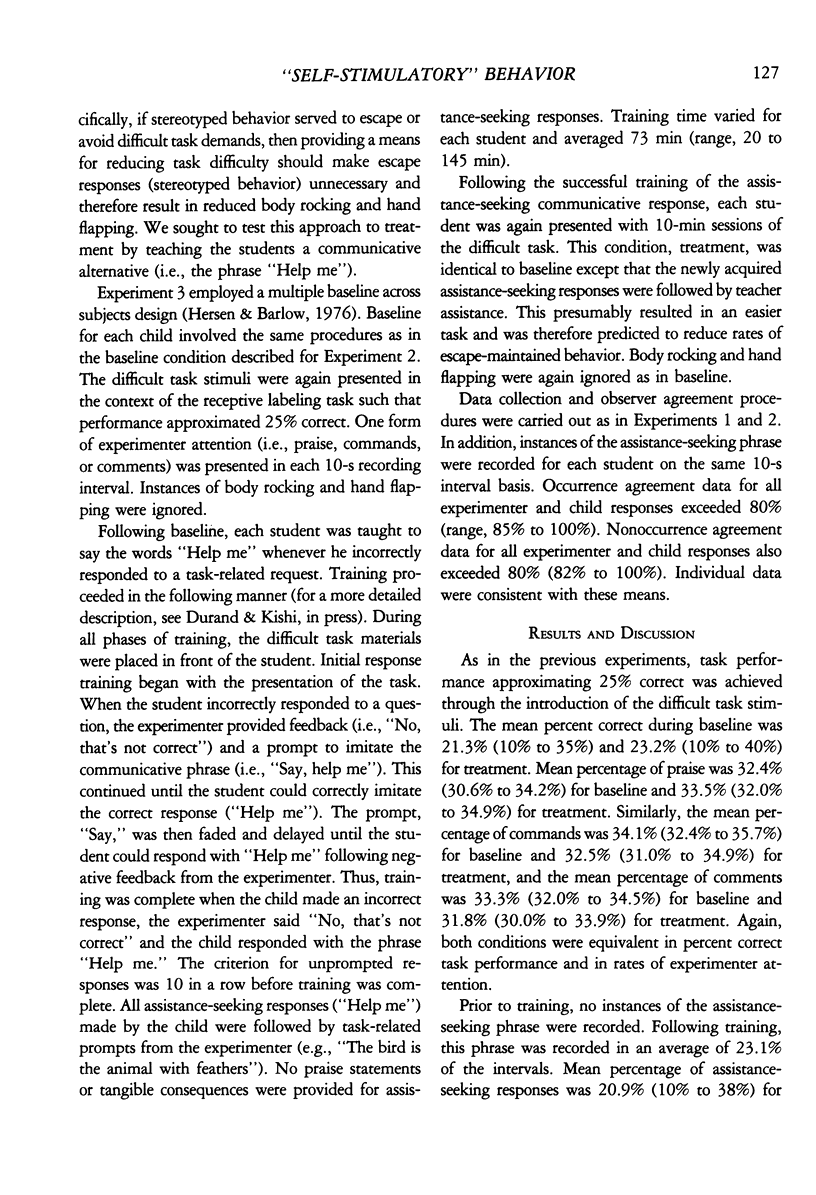
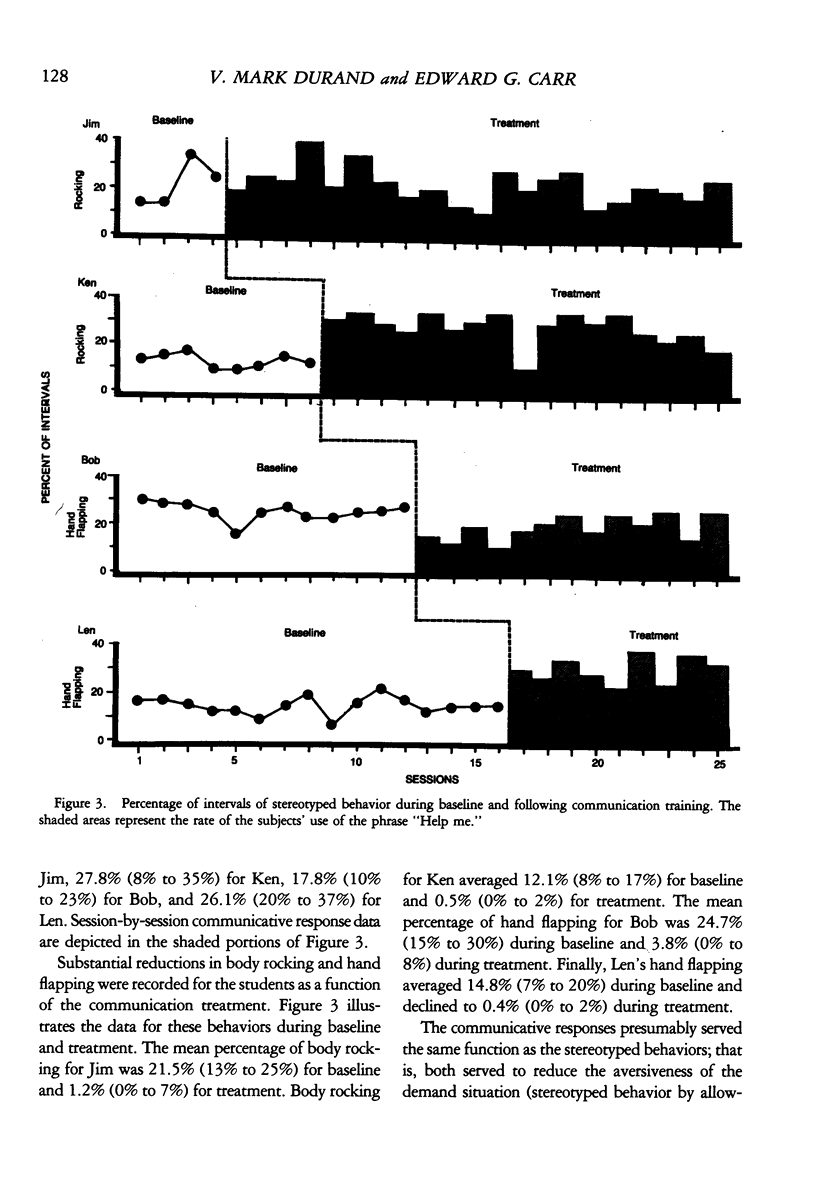
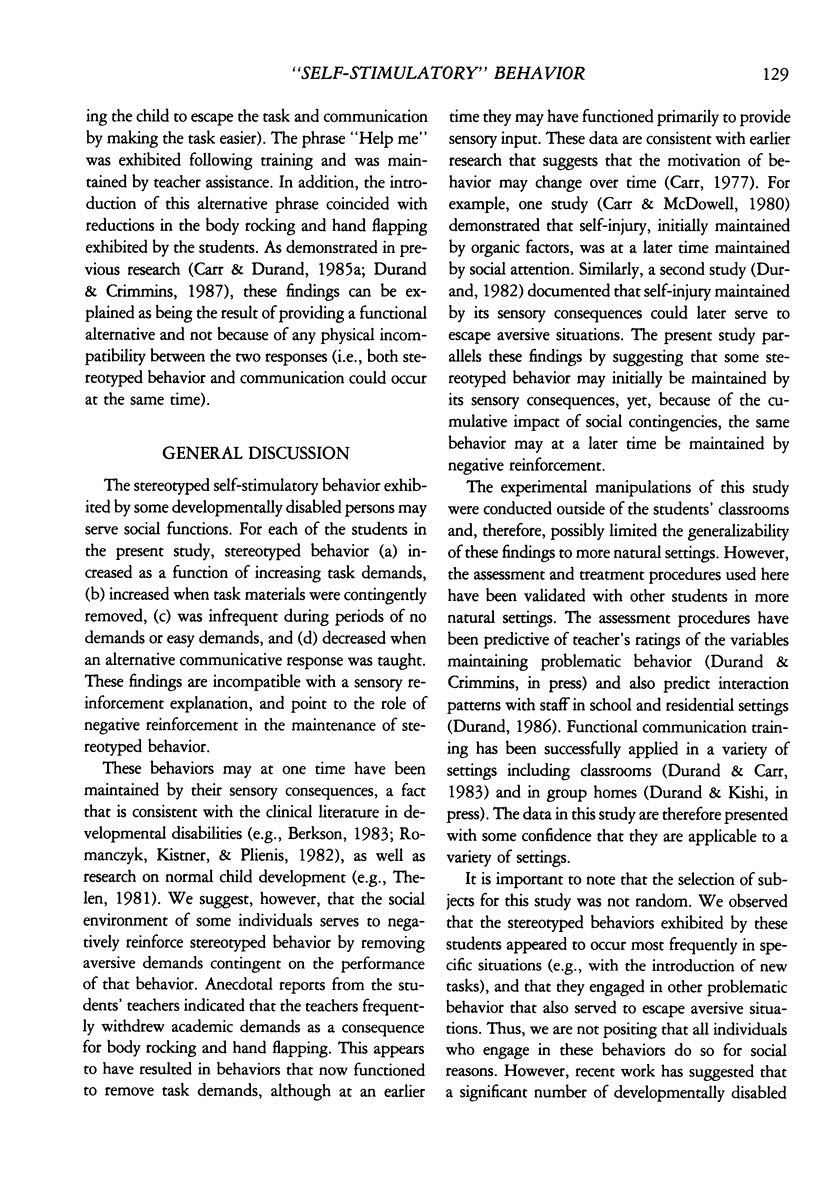
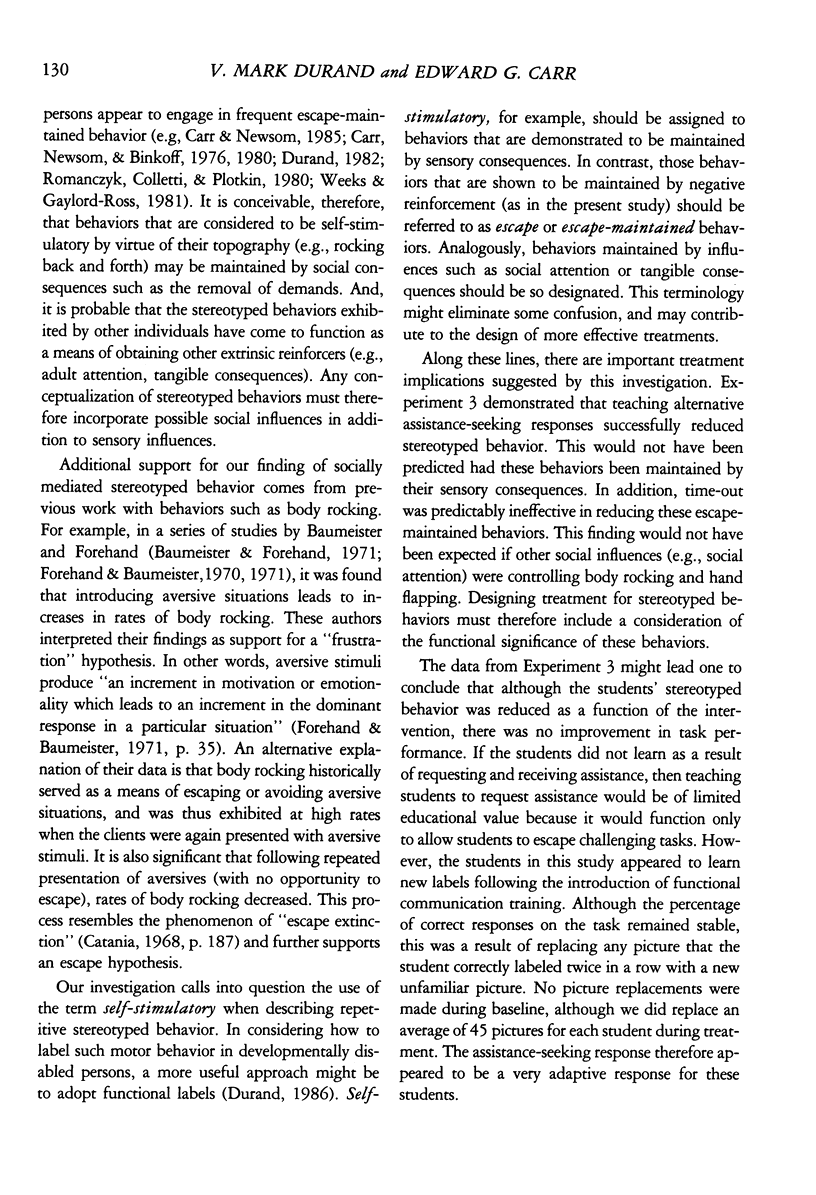
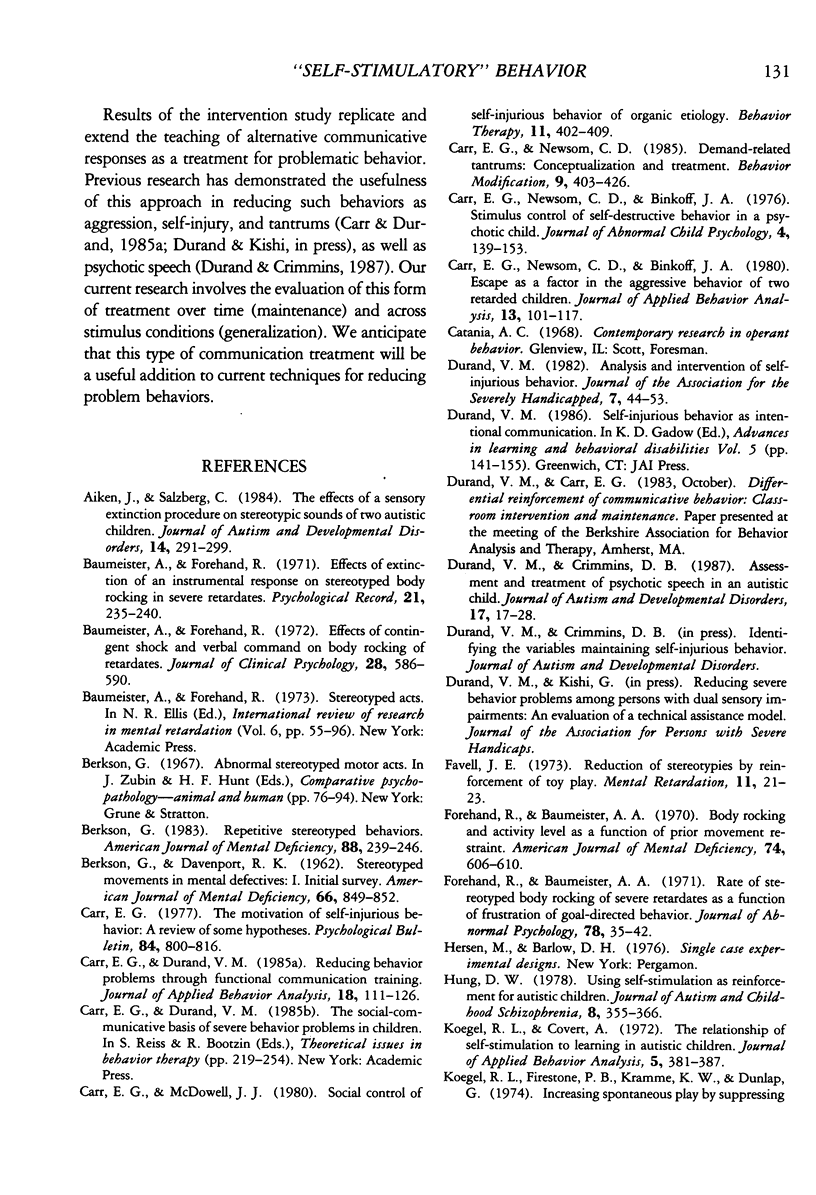
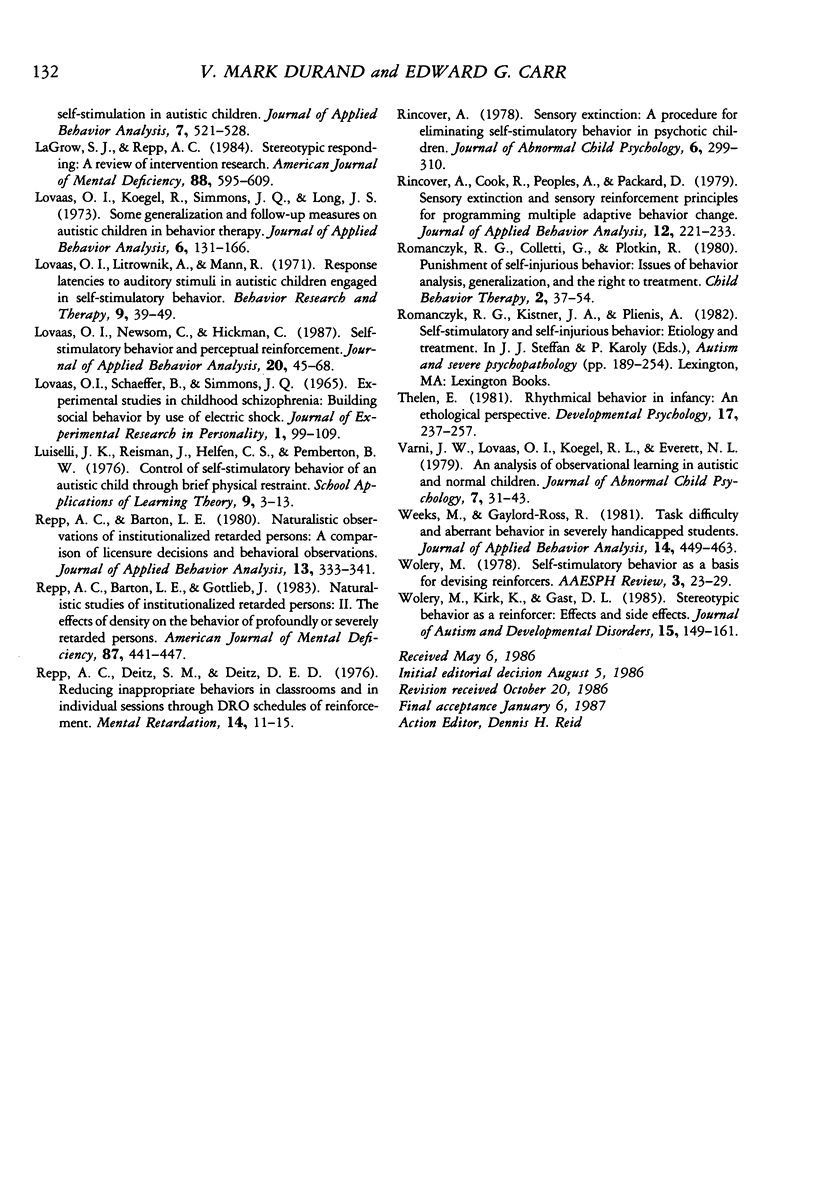
Selected References
These references are in PubMed. This may not be the complete list of references from this article.
- Aiken J. M., Salzberg C. L. The effects of a sensory extinction procedure on stereotypic sounds of two autistic children. J Autism Dev Disord. 1984 Sep;14(3):291–299. doi: 10.1007/BF02409580. [DOI] [PubMed] [Google Scholar]
- BERKSON G., DAVENPORT R. K., Jr Stereotyped movements of mental defectives. I. Initial survey. Am J Ment Defic. 1962 May;66:849–852. [PubMed] [Google Scholar]
- Baumeister A. A., Forehand R. Effects of contingent shock and verbal command on body rocking of retardates. J Clin Psychol. 1972 Oct;28(4):586–590. doi: 10.1002/1097-4679(197210)28:4<586::aid-jclp2270280442>3.0.co;2-8. [DOI] [PubMed] [Google Scholar]
- Berkson G. Repetitive stereotyped behaviors. Am J Ment Defic. 1983 Nov;88(3):239–246. [PubMed] [Google Scholar]
- Carr E. G., Durand V. M. Reducing behavior problems through functional communication training. J Appl Behav Anal. 1985 Summer;18(2):111–126. doi: 10.1901/jaba.1985.18-111. [DOI] [PMC free article] [PubMed] [Google Scholar]
- Carr E. G., Newsom C. D., Binkoff J. A. Escape as a factor in the aggressive behavior of two retarded children. J Appl Behav Anal. 1980 Spring;13(1):101–117. doi: 10.1901/jaba.1980.13-101. [DOI] [PMC free article] [PubMed] [Google Scholar]
- Carr E. G., Newsom C. D., Binkoff J. A. Stimulus control of self-destructive behavior in a psychotic child. J Abnorm Child Psychol. 1976;4(2):139–153. doi: 10.1007/BF00916518. [DOI] [PubMed] [Google Scholar]
- Carr E. G., Newsom C. Demand-related tantrums. Conceptualization and treatment. Behav Modif. 1985 Oct;9(4):403–426. doi: 10.1177/01454455850094001. [DOI] [PubMed] [Google Scholar]
- Carr E. G. The motivation of self-injurious behavior: a review of some hypotheses. Psychol Bull. 1977 Jul;84(4):800–816. [PubMed] [Google Scholar]
- Durand V. M., Crimmins D. B. Assessment and treatment of psychotic speech in an autistic child. J Autism Dev Disord. 1987 Mar;17(1):17–28. doi: 10.1007/BF01487257. [DOI] [PubMed] [Google Scholar]
- Forehand R., Baumeister A. A. Body rocking and activity level as a function of prior movement restraint. Am J Ment Defic. 1970 Mar;74(5):608–610. [PubMed] [Google Scholar]
- Hung D. W. Using self-stimulation as reinforcement for autistic children. J Autism Child Schizophr. 1978 Sep;8(3):355–366. doi: 10.1007/BF01539637. [DOI] [PubMed] [Google Scholar]
- Koegel R. L., Covert A. The relationship of self-stimulation to learning in autistic children. J Appl Behav Anal. 1972 Winter;5(4):381–387. doi: 10.1901/jaba.1972.5-381. [DOI] [PMC free article] [PubMed] [Google Scholar]
- Koegel R. L., Firestone P. B., Kramme K. W., Dunlap G. Increasing spontaneous play by suppressing self-stimulation in autistic children. J Appl Behav Anal. 1974 Winter;7(4):521–528. doi: 10.1901/jaba.1974.7-521. [DOI] [PMC free article] [PubMed] [Google Scholar]
- LaGrow S. J., Repp A. C. Stereotypic responding: a review of intervention research. Am J Ment Defic. 1984 May;88(6):595–609. [PubMed] [Google Scholar]
- Lovaas I., Newsom C., Hickman C. Self-stimulatory behavior and perceptual reinforcement. J Appl Behav Anal. 1987 Spring;20(1):45–68. doi: 10.1901/jaba.1987.20-45. [DOI] [PMC free article] [PubMed] [Google Scholar]
- Lovaas O. I., Koegel R., Simmons J. Q., Long J. S. Some generalization and follow-up measures on autistic children in behavior therapy. J Appl Behav Anal. 1973 Spring;6(1):131–165. doi: 10.1901/jaba.1973.6-131. [DOI] [PMC free article] [PubMed] [Google Scholar]
- Lovaas O. I., Litrownik A., Mann R. Response latencies to auditory stimuli in autistic children engaged in self-stimulatory behavior. Behav Res Ther. 1971 Feb;9(1):39–49. doi: 10.1016/0005-7967(71)90035-0. [DOI] [PubMed] [Google Scholar]
- Repp A. C., Barton L. E., Gottlieb J. Naturalistic studies of institutionalized profoundly or severely mentally retarded persons: the relationship of density and behavior. Am J Ment Defic. 1983 Jan;87(4):441–447. [PubMed] [Google Scholar]
- Repp A. C., Barton L. E. Naturalistic observations of institutionalized retarded persons: a comparison of licensure decisions and behavioral observations. J Appl Behav Anal. 1980 Summer;13(2):333–341. doi: 10.1901/jaba.1980.13-333. [DOI] [PMC free article] [PubMed] [Google Scholar]
- Repp A. C., Deitz S. M., Deitz D. E. Reducing inappropriate behaviors in classrooms and in individual sessions through DRO schedules of reinforcement. Ment Retard. 1976 Feb;14(1):11–15. [PubMed] [Google Scholar]
- Rincover A., Cook R., Peoples A., Packard D. Sensory extinction and sensory reinforcement principles for programming multiple adaptive behavior change. J Appl Behav Anal. 1979 Summer;12(2):221–233. doi: 10.1901/jaba.1979.12-221. [DOI] [PMC free article] [PubMed] [Google Scholar]
- Rincover A. Sensory extinction: a procedure form eliminating self-stimulatory behavior in developmentally disabled children. J Abnorm Child Psychol. 1978 Sep;6(3):299–310. doi: 10.1007/BF00924733. [DOI] [PubMed] [Google Scholar]
- Varni J. W., Lovaas O. I., Koegel R. L., Everett N. L. An analysis of observational learning in autistic and normal children. J Abnorm Child Psychol. 1979 Mar;7(1):31–43. doi: 10.1007/BF00924508. [DOI] [PubMed] [Google Scholar]
- Weeks M., Gaylord-Ross R. Task difficulty and aberrant behavior in severely handicapped students. J Appl Behav Anal. 1981 Winter;14(4):449–463. doi: 10.1901/jaba.1981.14-449. [DOI] [PMC free article] [PubMed] [Google Scholar]
- Wolery M., Kirk K., Gast D. L. Stereotypic behavior as a reinforcer: effects and side effects. J Autism Dev Disord. 1985 Jun;15(2):149–161. doi: 10.1007/BF01531601. [DOI] [PubMed] [Google Scholar]


